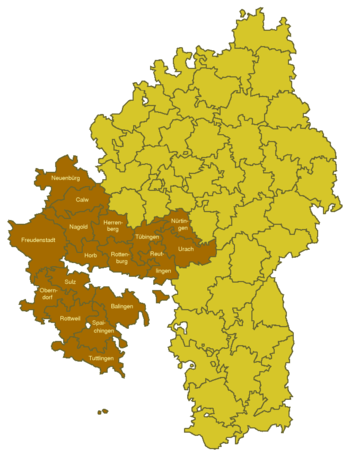Black Forest District
The Black Forest District was one of four districts in the Kingdom of Württemberg . It was formed in 1818 and dissolved in 1924. "Canzley" (ie capital) of the district was Reutlingen . The highest authority of the district, called "Government", was housed until 1905 in the building of the former Barefoot Monastery, which is now the Friedrich-List-Gymnasium . Functionally, the Black Forest district can be roughly compared with today's administrative district , but not with today's district . Its area is divided into all four current administrative districts ( Freiburg , Karlsruhe , Stuttgart and Tübingen ), with the administrative district of Tübingen having the largest share.
By placing the "government" in Reutlingen, the aim was to make membership of Württemberg attractive to the imperial city, which was free until recently . This was a challenge because Reutlingen did not have the appropriate officials at the time and they all - the "director" or the district president as well as "Räthe", "assessors", "expeditors" and "office lists" - had to come from other cities. The city of Reutlingen had to prepare the government building as well as the apartment of the district president at its own expense, whereby "any unnecessary effort was to be avoided". At the same time, there was a lack of apartments of the appropriate class in Reutlingen, which were also affordable. The officials complained that the city of Reutlingen had to be requested as early as 1819 to remedy these deficiencies immediately - with the threat that the “government” would otherwise be relocated to another city.

Since the former monastery building was no longer sufficient as the seat of government, a new building was built in Bismarckstrasse , completed in 1905, which is now the district office.
The Black Forest District also had its own court. It was an appeals court that reviewed the judgments of the local courts. Its seat was Tübingen, which in this way got a certain replacement for the court court that was located there until 1806 . The court was temporarily housed in the former "Adler" inn on the corner of the Holzmarkt and Neue Straße , which, however, was unreasonable in the long run. After long deliberations, the city built the courthouse on the same spot (today's address Neue Straße 1) according to the plans of the district building councilor Christian Friedrich Roth, which was completed in 1830. From 1875 the officers' mess was located in the building, in 1912 it was sold to private customers and converted into a trading house.
The Black Forest district was divided into the following main offices , which were similar to today's counties:
| Oberamt | license plate |
|---|---|
| Balingen |
III H
|
| Calw |
III H
|
| Freudenstadt |
III H
|
| Herrenberg |
III H
|
| Horb |
III H
|
| Nagold |
III H
|
| Neuenbürg |
III K
|
| Nürtingen |
III K
|
| Oberndorf |
III K
|
| Reutlingen |
III K
|
| Rottenburg |
III K
|
| Rottweil |
III M
|
| Spaichingen |
III M
|
| Sulz |
III M
|
| Tübingen |
III M
|
| Tuttlingen |
III M
|
| Urach |
III M
|
Directors
The government of the Black Forest district was headed by a government director. The king was able to give him the honorary title of district president .
- 1817–1835 Franz Josef Ignaz von Linden , district president
- 1835–1847 Anton Peter von Rummel , government director
- 1847–1854 Carl Julius Wilhelm Ernst von Schumm , government director
- 1854–1870 Ludwig August von Autenrieth , government director
- 1870–1880 Ludwig von Schwandner , district president
- 1882–1896 Karl von Luz , district president
- 1896–1904 Karl von Bellino , District President
- 1904–1921 Friedrich von Hofmann , district president
- 1922–1924 Adolf von Nickel , District President
See also
- Donaukreis , Jagstkreis and Neckarkkreis
- Baar (landscape)
- Administrative division of Württemberg
- Kingdom of Württemberg
- People's State of Württemberg
proof
- ↑ a b "Government" in the Achalm city . In: »Tübinger Wochenblatt« October 25, 2018, p. 7.
- ↑ Udo Rauch: All about the wood market . In: Udo Rauch (ed): Between Ammer and Neckar. The changing cityscape of Tübingen , Kulturamt Tübingen 1994, ISBN 3-910090-11-7 , p. 125.

